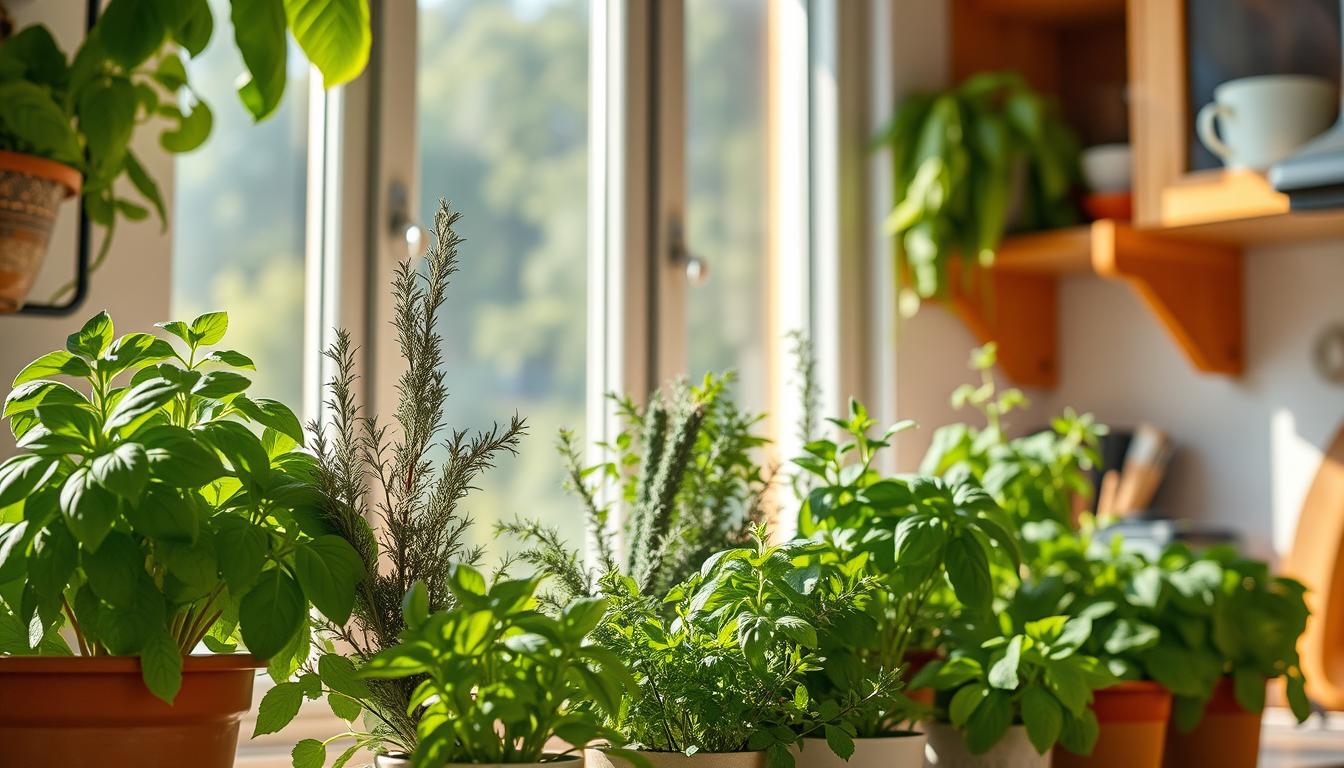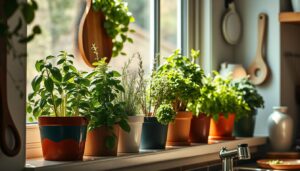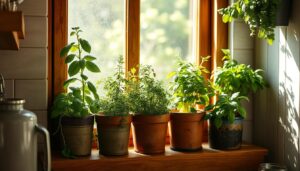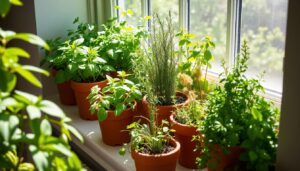Did you know the global indoor gardening market is set to hit $9.7 billion by 2027? More folks are turning to indoor herb gardening to enjoy fresh, fragrant flavors at home. It’s a hobby that’s both rewarding and relaxing.
This guide will help you pick the best herbs for your indoor garden. You’ll learn how to create a thriving space and keep your herbs healthy. Even if you’re new to gardening, you can grow your own herbs indoors with ease.
By the end, you’ll be all set to enjoy fresh, aromatic herbs all year long.
Key Takeaways
- The global indoor gardening market is expected to reach $9.7 billion by 2027, indicating the growing popularity of indoor herb growing.
- Growing your own herbs indoors provides a steady supply of fresh, flavorful ingredients and can be a rewarding hobby.
- This guide will teach you how to choose the best herbs for indoor growing, set up a thriving environment, and maintain a healthy herb garden.
- Even beginner gardeners with limited space can enjoy the convenience and satisfaction of homegrown herbs year-round.
- The article covers essential topics like choosing the right herbs, container and soil requirements, lighting needs, watering, and more to help you succeed with indoor herb gardening.
Introduction: The Joy of Fresh, Homegrown Herbs
Nothing beats the smell and taste of fresh, homegrown herbs. Whether you’re adding basil to pasta, cilantro to guacamole, or mint to cocktails, growing herbs indoors is a game-changer. It brings unmatched flavor and aroma to your dishes.
Benefits of Growing Herbs Indoors
Starting an indoor herb garden lets you have flavorful homegrown herbs all year, even without outdoor space. The main perks of growing herbs indoors are:
- Easy access to a variety of best indoor herbs for cooking
- Harvesting fresh, aromatic herbs whenever you want
- Saving money by not buying herbs from the store
- Lowering your carbon footprint by cutting down on transportation and packaging
- Enjoying the calming effects of taking care of indoor plants
Popular Culinary Herbs for Indoor Gardens
Some herbs do exceptionally well indoors, thanks to the controlled home environment. The top culinary herbs for indoor gardens are:
- Basil
- Chives
- Cilantro
- Mint
- Oregano
- Parsley
- Rosemary
- Sage
- Thyme
With a bit of care, these flavorful homegrown herbs can give you a steady supply all year. This lets you fully enjoy the advantages of growing herbs indoors.
Choosing the Right Herbs for Indoor Growing
When picking herbs for your indoor garden, think about what light and humidity they need. Picking the right herbs means they’ll grow well and give you lots of fresh, tasty herbs.
Mediterranean Herbs for Sunny Environments
If your indoor spot gets a lot of sunlight, Mediterranean herbs are great. Rosemary, thyme, and oregano love dry, sunny places. They bring a taste of the Mediterranean to your kitchen garden.
Moisture-Loving Herbs for Humidity
For humid indoor spaces, choose herbs that like moist air. Mint and parsley do well in humid conditions. They’ll give you fresh herbs for cooking.
It’s key to know what each herb needs for light and humidity. Matching herbs with your indoor conditions helps your garden grow well. Look for best indoor herbs for sunny windows and herbs that thrive in humidity. This way, you’ll find the perfect herb selection for indoor gardens.
“The secret to a bountiful indoor herb garden is finding the right balance of light, humidity, and plant selection.”
Setting Up Your Indoor Herb Garden
Starting an indoor herb garden needs the right start. Picking the best indoor herb garden containers and soil is key. This ensures your herbs grow well and thrive. With good drainage and the right soil, you’re on your way to a great herb container gardening setup.
Containers and Drainage Requirements
Choose pots that are at least 6 inches wide and deep for your indoor herbs. This size lets most herbs grow well. Make sure the pots have good drainage holes to stop water from pooling and causing root rot.
Use materials like terracotta, ceramic, or quality plastic. These allow air to get in and help control moisture.
Soil Mixes for Indoor Herb Gardens
Don’t use regular garden soil for your potting soil for indoor herbs. Go for a soilless mix made for containers. These mixes have peat moss, vermiculite, and perlite for good air and moisture.
Add a slow-release organic fertilizer to the soil. This gives your herbs steady nutrients all season.
“The key to a thriving indoor herb garden is ensuring the right growing conditions from the very beginning.”
Choosing the right indoor herb garden containers and soil sets you up for success. You’ll get a lot of fresh, tasty herbs all year.
Growing Herbs from Seeds, Cuttings, or Starter Plants
Starting your indoor herb garden can be done in a few ways – from seeds, cuttings, or starter plants. Each method has its own benefits and things to consider. Let’s look at the best choice for you.
Growing herbs from seed needs patience but lets you try many types of herbs. It’s perfect if you want to explore new or special herbs. Remember, it can take weeks before you see your herbs grow.
If you have an outdoor herb garden or house plants, you can propagate cuttings and grow them in water. Once roots form, move the cuttings to your indoor garden. This way, you can grow your favorite herbs easily.
For a fast start, think about using starter plants from a nursery or garden center. These young plants are ready to go, making your indoor garden quick to set up.
No matter your choice, make sure to keep new plants away from your current ones. This stops pests or diseases from spreading and harming your herbs.
With some planning and the right method, you can have fresh, homegrown herbs all year. Enjoy the benefits of your indoor herb garden from home.
Providing Optimal Light Conditions
Herbs love the sun and need lots of light to grow well indoors. Most herbs need at least 6 hours of sunlight each day. South-facing windows give the best light. If your home doesn’t get enough sunlight, you can use grow lights to help your herbs grow.
Sunlight Requirements for Different Herbs
Herbs like rosemary, thyme, and oregano love bright sunlight. They do best on sunny windowsills. Parsley, chives, and mint prefer softer light from east- or west-facing windows. It’s important to know what light your herbs need to grow well indoors.
Using Grow Lights for Indoor Herb Gardens
If your home lacks enough sunlight, add full-spectrum grow lights near your plants. Turn the lights on for 12-16 hours a day. This supplemental lighting is key for growing herbs in sunny windows or other dim spots at home.
“Proper lighting is the key to a lush, productive indoor herb garden. With a little planning and the right setup, you can enjoy fresh, flavorful herbs year-round, even in the depths of winter.”
| Herb | Sunlight Needs | Recommended Grow Light |
|---|---|---|
| Rosemary | 6-8 hours of direct sunlight | Full-spectrum LED grow light |
| Basil | 6-8 hours of direct sunlight | Fluorescent or LED grow light |
| Parsley | 4-6 hours of indirect sunlight | Compact fluorescent or LED grow light |
| Mint | 4-6 hours of indirect sunlight | Fluorescent or LED grow light |
Best herbs for indoor growing beginners
If you’re new to indoor gardening, start with some of the easiest herbs to grow indoors. These low-maintenance, starter indoor herb garden essentials will help you build confidence and experience. Before you expand your indoor oasis. Some of the best herbs for indoor growing beginners include:
- Basil – A fast-growing, flavorful herb that thrives in bright, sunny conditions.
- Chives – A hardy, resilient herb that adds a delicate onion-like flavor to dishes.
- Mint – An incredibly vigorous grower that can spice up your meals and cocktails.
- Oregano – A Mediterranean herb that flourishes with ample sunlight and moderate watering.
- Parsley – A staple herb that’s easy to grow and a versatile addition to any kitchen garden.
- Rosemary – A drought-tolerant herb with a distinctive, pine-like aroma and flavor.
- Thyme – A low-maintenance herb that adds earthy, savory notes to a variety of recipes.
By focusing on these reliable, easy-to-grow herbs, you’ll be well on your way to enjoying the rewards of fresh, flavorful homegrown herbs. Even in the comfort of your own home.
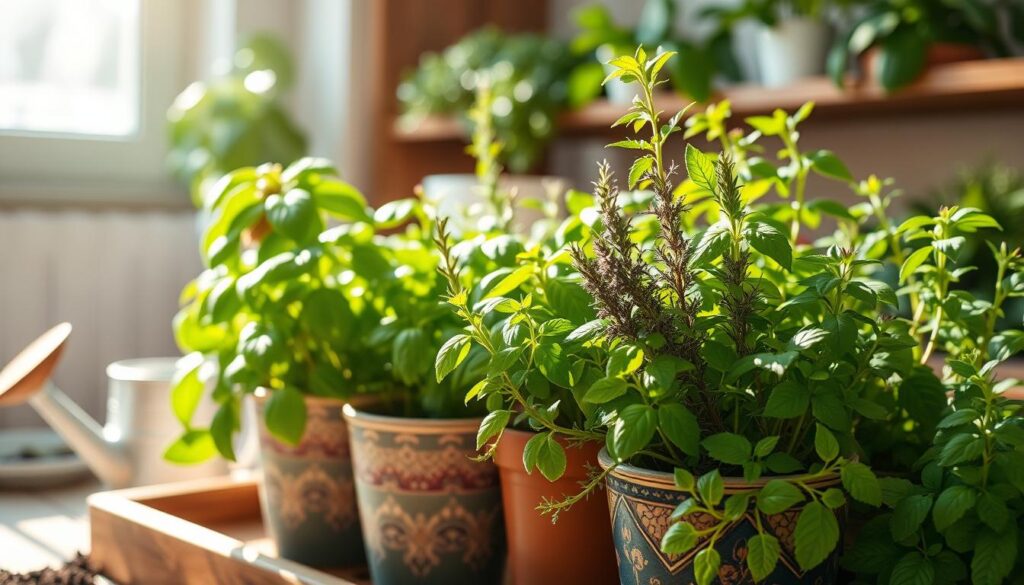
“Growing your own herbs is one of the easiest and most rewarding ways to experiment with fresh, flavorful ingredients right at home.”
Watering and Humidity Needs for Indoor Herbs
Keeping the right moisture and humidity is key for your indoor herbs. By following simple tips, your potted plants will thrive. This means you’ll get fresh, flavorful herbs all year.
Monitoring Soil Moisture Levels
Right indoor herb watering is crucial. Let the soil dry out a bit before watering again. Check the moisture by sticking your finger into the soil up to the first knuckle. Water when the top inch or two feels dry.
Don’t let the soil get too dry or too wet. Both can harm your plants.
Here are tips to keep soil moisture right for potted herbs:
- Water thoroughly, making sure the entire soil mass is moistened, not just the surface.
- Adjust watering based on plant size, pot size, and environmental conditions.
- Use your finger or a moisture meter to check when the soil needs more water.
Managing Humidity for Indoor Herbs
Boost the humidity around your indoor herbs to mimic their natural environment. Mist the plants often, put pots on pebble trays, or use a humidifier, especially in dry winter months.
| Herb | Ideal Humidity Range |
|---|---|
| Basil | 40-60% |
| Mint | 50-70% |
| Rosemary | 30-50% |
| Thyme | 40-60% |
Keep an eye on soil moisture levels and humidity for your indoor herbs. This will keep them healthy and productive. You’ll have a steady supply of fresh, flavorful leaves for your cooking all year.
Temperature and Air Circulation Considerations
Keeping the right temperature and airflow is key for your indoor herb garden’s health and growth. Most herbs do well in a temperature between 65-75°F, just like it is for people. Don’t put your herbs near drafty spots or cold windows. Fluctuating temperatures and cold air can harm the plants.
To get the air moving for your herbs, think about placing a fan nearby or changing the pot’s position. Stagnant air can spread diseases, so moving air is crucial. Proper air flow is important for both potted and indoor herb gardens.
Knowing the ideal indoor temperature for herbs and how to keep the air moving helps your garden succeed. With the right conditions, you’ll have fresh, tasty herbs all year.
“The secret to a thriving indoor herb garden is providing the perfect balance of temperature and air movement.”
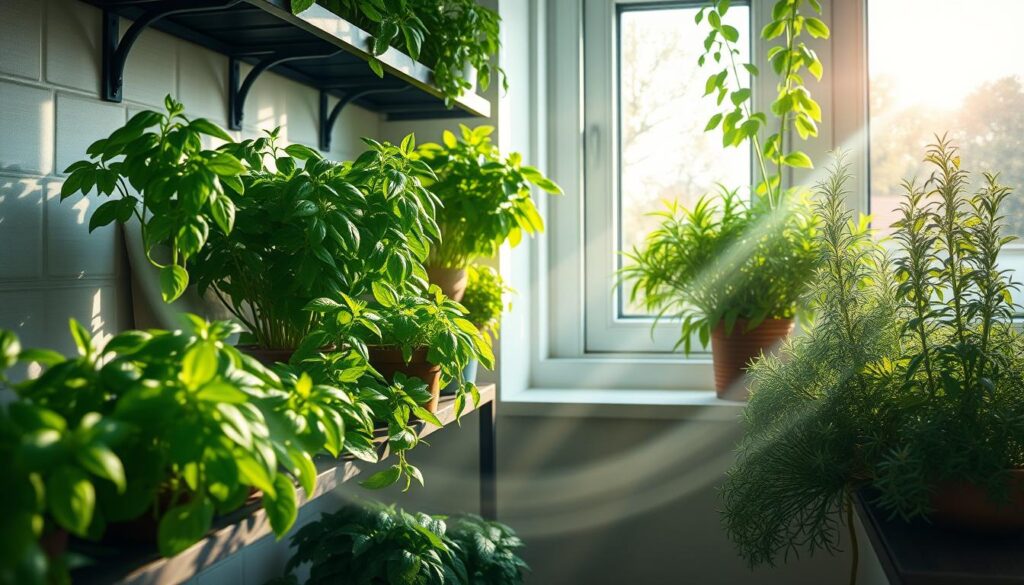
- Maintain a temperature range of 65-75°F for optimal herb growth
- Avoid drafty areas and direct exposure to cold windows
- Use a fan or periodically rearrange pots to create gentle air circulation
- Prevent stagnant air to minimize the spread of plant diseases
Fertilizing and Maintaining Your Indoor Herb Garden
Caring for an indoor herb garden means giving them a little extra love. Since they can’t get nutrients from the ground like outdoor plants do, they need help. Use a balanced liquid fertilizer or fish emulsion every 2-4 weeks during the growing season. Make sure to use it at half the strength recommended on the label. Don’t overdo it with the fertilizer, as it can harm your plants.
To keep your indoor herbs in top shape, prune and harvest them often. This encourages them to grow bushier and more productive. Remove any dead or damaged leaves or stems to keep your garden looking neat. It also helps promote new, healthy growth. Feeding and pruning your herbs right is key to having a fresh, flavorful supply all year.
| Nutrient Requirements for Potted Herbs | Feeding Frequency | Fertilizer Strength |
|---|---|---|
| Balanced, all-purpose liquid fertilizer or fish emulsion | Every 2-4 weeks during growing season | Half the recommended strength |
Proper feeding indoor herbs and care is crucial for their health and productivity. With a bit of effort, you can enjoy a steady supply of fresh, homegrown herbs all year.
“The secret to a thriving indoor herb garden is in the details – from nutrient-rich soil to thoughtful pruning. With a little TLC, your herbs will reward you with an abundance of flavor.”
Conclusion: Enjoy Fresh, Flavorful Herbs Year-Round
Growing an indoor herb garden lets you enjoy fresh, vibrant flavors of homegrown herbs all year. Even if you don’t have outdoor space, you can still grow herbs indoors. By picking the right herbs and giving them the right care, you can have a kitchen garden that always has aromatic herbs.
Starting an indoor herb garden is great for both new and experienced gardeners. It’s rewarding and practical. Having those essential herbs ready to use means you can always add flavor to your cooking. You’ll love the advantages of homegrown indoor herbs and the joy of growing your own food at home.
So, why not start your indoor herb gardening journey? With the right knowledge and care, your garden will flourish. It will become a key part of your cooking.
FAQ
What are the best herbs for indoor growing beginners?
How much light do indoor herbs need?
How often should I water my indoor herbs?
What type of potting mix should I use for an indoor herb garden?
How do I maintain humidity levels for my indoor herbs?
How often should I fertilize my indoor herb garden?
Source Links
- The 12 Easiest Herbs to Grow Inside – https://www.realsimple.com/food-recipes/shopping-storing/herbs-spices/easiest-herbs-to-grow
- Ultimate Beginner’s Guide to Growing Herbs Indoors – https://www.planetnatural.com/grow-herbs-indoors/
- Indoor Herb Garden: How to Get Started! – https://www.almanac.com/growing-herbs-indoors


